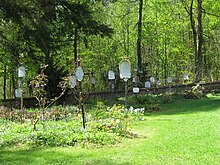St. Clemens (Oberberghausen)
The St. Clemens branch church , also known as the Oberberghausen Forest Chapel , is a small Catholic church in the Oberberghausen desert in the municipality of Kranzberg in Upper Bavaria .
The church is dedicated to St. Consecrated to Clement of Rome . The church, the furnishings of the church, the wrought iron grave crosses in the cemetery and the cemetery wall are under monument protection.
location
The church with a ridge turret and a small sign in the west as an entrance hall stands about 1250 meters southwest of Ampertshausen on a gentle hill in a clearing in the Kranzberger Forest . It is closed except for occasional church services.
Architecture and equipment
Today's church is Romanesque in the core (nave) , but was remodeled in the 18th century in Baroque style. The furnishings of the church also come from the Baroque period. On the high altar the two figures flanking the altarpiece are made using the laminating technique . In the 17th century, lengths of fabric soaked in glue were formed on a wooden board in such a way that they looked as if they had been carved after painting . The building is surrounded on three sides by a walled cemetery with 28 wrought iron grave crosses from the 18th and 19th centuries.
history
There was probably a small, wooden chapel here as early as the early 6th century . The name “Perechhusa” appears for the first time in a document in 926 as part of an exchange between Bishop Wolfram and the noble and knight Adalhoh . The current church was probably built in the 11th century, shortly after the "estates of Pergkhausen" came to the Weihenstephan Benedictine monastery as a fief under the Freising Bishop Egilbert (1006-1039) . In the decades after 1140 the heyday of the place can be set. With the secularization , the surrounding land (forest) passed to the Bavarian state and became a state forest.
Today's "forest chapel" served as a village church for the four farms in the hamlet of Oberberghausen, which have been documented since the 16th century . The courtyards consisted of three to four buildings each, the corridor covered around 85 hectares in 1810 and was surrounded by state forest. It was here that experiments with foreign tree species were first made around 1877. Around 1880 the idea took shape to create a willow culture in the Kranzberger Forst . The aim was to create new employment opportunities for the population. In order to create a closed area (state forest and village), the farmers should sell. The farmers initially opposed the forest administration's intentions to buy, but were "persuaded" to sell their property with the tolerance of the royal Bavarian government. In 1883 the now useless church was incorporated into the parish of Wippenhausen . The last resident of the village, Josef Reichart, left his farm in 1884.
In the same year the willow garden began to be laid out, which would later include 800 species and varieties. For a short time, the willow extensions in the Kranzberger Forest became a magnet for foresters from all over the world. Farm buildings were built and accommodation and food options were created. On July 21, 1884, the inauguration of the "willow bush" took place with many traditional eulogies and promises. The income, however, remained far below expectations (e.g. in 1898 only 350 marks instead of the expected 9,000 to 12,000 marks annual net proceeds). The enthusiasm evaporated quickly. What is left is a forest with “exotic species” from this period, which the Bavarian State Forests maintain and develop as the Bavarian State Arboretum. There is an information pavilion .
As a result, the former village church fell into disrepair. It was only repaired on the initiative of Georg Klebel (1852–1943), a royal professor at the Freising secondary school . Today the Association for the Preservation of the Forest Church in Oberberghausen looks after the building.
The church is only used occasionally for services and weddings . Benches exist in the west and north of the church. An open-air performance by the Laienbühne Freising eV took place in 2005. The then very successful interpretation of the Ludwig Thoma drama Magdalena was repeated from July to August 2011.
literature
- Josef Hofmiller: The idyll of Oberberghausen . In: Wanderbilder and pilgrimages . 6th edition. tape 3 . Karl Rauch, Leipzig 1932 ( projekt-gutenberg.org ).
- Wolter von Egan-Krieger: "Title unknown" . In: Süddeutsche Zeitung . December 27, 1985.
- Veronika Stegmann, Chris Loos (ed.): Historical traces in the cultural landscape of the Middle Isar region . Institute for Landscape Architecture at the Weihenstephan-Triesdorf University of Applied Sciences, Freising 2014.
Web links
Individual evidence
- ↑ File number: D-1-78-137-8
- ↑ a b c V. Stegmann (Ed.): Historical traces in the cultural landscape ... p. 17 .
Coordinates: 48 ° 24 ′ 50.1 ″ N , 11 ° 39 ′ 59.5 ″ E


